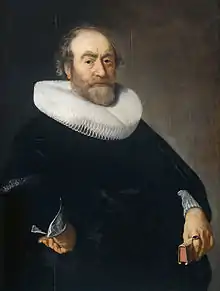Andries Bicker
Andries Bicker (1586 – 24 June 1652) was a wealthy Dutch merchant in Russia, a member of the vroedschap, the leader of the Arminians, an administrator of the VOC, representative of the States-General of the Netherlands and colonel in the Civic guard.[1] He controlled the city's politics in close cooperation with his uncle Jacob Dircksz de Graeff and his brother Cornelis Bicker.
Andries Bicker | |
|---|---|
 | |
| Regent and Mayor of Amsterdam | |
| In office 1627–1650 | |
| Preceded by | Jacob de Graeff Dircksz. |
| Succeeded by | Cornelis de Graeff |
| President of the Dutch East Indies Company | |
| Preceded by | [data unknown/missing] |
| Succeeded by | Cornelis de Graeff |
| Personal details | |
| Nationality | Dutch |
| Political party | States Faction |
| Spouse(s) | Catharina Gansneb von Tengnagel |
| Relations | Cornelis Bicker (brother) Jan Bicker (brother) Cornelis de Graeff (cousin) Andries de Graeff (cousin) Johan de Witt (nephew) Cornelis de Witt (nephew) |
| Children | Gerard |
| Residence | Herengracht, Amsterdam, castle Engelenburg near Brummen |
| Occupation | Regent / Mayor and Landlord |
| Profession | Merchant |
The Bicker family was one of the oldest patrician families of Amsterdam – consisting of Andries' father Gerrit, a grain merchant and beer brewer, and his three brothers, Jacob, Jan and Cornelis, had a firm grip on world trade, trading on the East, the West, the North and the Mediterranean. (His uncle Laurens Bicker was one of the first to trade on Guinea and seized four Portuguese ships in 1604). In 1646, seven members of the Bicker family, called the Bicker's league, simultaneously held some political position or other. The Bickers provided silver and ships to Spain, and were very much interested in ending the Eighty Years War. This brought them in conflict with the stadtholder, some provinces, like Zeeland and Utrecht, and the Reformed preachers.[2]
Life
Andries became a member of the vroedschap in 1616, in 1620 schepen of Amsterdam and in 1627, just over forty, mayor of Amsterdam. He came to the fore through his knowledge and moderation. In 1627, he was delegated to go to Sweden and Poland, to close negotiations between these two countries, mediate a peace (culminating in the Treaty of Sztumska Wieś) and at the same time set up new Baltic trade agreements. In 1631 he was the owner of a few plots in Spanderswoud in 's-Graveland, the site where now the fine Trompenburgh house stands. The Bicker family also had concerns in peat-digging in Drenthe.
At the solemn entry of Maria de Medici into Amsterdam in 1638, he and Albert Burgh welcomed her in the name of the city's government. In 1643, he went with Jacob de Witt to Sweden to mediate between Sweden and Denmark. Andries Bicker opposed the stadtholder Frederick Henry, Prince of Orange, who intended the centralize the five admiralties, which would cause the Admiralty of Amsterdam to lose influence.[3]
After the Peace of Münster was signed, Bicker was of the opinion that it was no longer necessary to maintain a standing army, bringing him into vehement conflict with prince Willem II,[4] who had succeeded his father Frederick Henry as stadtholder. To regain power William went on the march towards Dordrecht and Amsterdam with an army. His troops got lost in a dense fog and were discovered by the postal courier on Hamburg, who also warned Andries' son Gerard, the high bailiff of Muiden, to leave without delay for Amsterdam. The mayors of Amsterdam had the civic guard called out, the bridges raised, the gates closed and the artillery dragged into position.
Andries Bicker was purged from the vroedschap, as was his brother Cornelis, as one of the conditions of the treaty that followed, led by Joan Huydecoper van Maarsseveen.[5] Henceforth, it was the equally republican-minded brothers Cornelis and Andries de Graeff, and their following, who dominated Amsterdam.[6] His niece Wendela Bicker married the powerful raadspensionaris Johan de Witt.[7]
Notes and references
- Kruizinga, J.H. (1986) De westelijke eilanden van Amsterdam, p. 17. (in Dutch)
- Israel, J. (1995) The Dutch Republic, Its Rise, Greatness, and Fall 1477-1806. Clarendon Press, Oxford, p. 545.
- Burke, P. (1974) Venice and Amsterdam. London: Temple Smith, p. 59?
- Israel, J. (1995) The Dutch Republic, Its Rise, Greatness, and Fall 1477-1806. p. 602.
- Israel, J. (1995) The Dutch Republic, Its Rise, Greatness, and Fall 1477-1806, p. 607.
- Israel, J. (1995) The Dutch Republic, Its Rise, Greatness, and Fall 1477-1806, p. 704.
- Panhuysen, L. (2005) De Ware Vrijheid, De levens van Johan en Cornelis de Witt. pp. 181–183.
External links
| Wikimedia Commons has media related to Andries Bicker. |